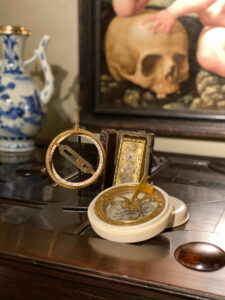Travel Essentials of the Past

Pedometer in its Original Leather Case
Double solar ring dial Johann Martin
Next time we are going to travel, there will be a few essentials on our packing list - phone (with google maps and other travel apps), iPad/laptop and probably several other electronic devices.
The essential tech for the well-equipped Renaissance and Baroque traveller looked a little different, but was certainly as much at the height of technology at the time than all the devices we are taking with us these days.
We show here several technical wonders of their age, offered by Georg Laue, Kunstkammer Ltd., London. Three outstanding pocket-sized gems that beautifully combine science, art and the most exquisite craftsmanship: a pedometer or pace counter (fig 1) in its leather case made in the early 18-century to measure the distance covered by foot, a Renaissance sundial made and signed by the Amsterdam instrument maker Joost de Beer (fig 2) that is set in a round, unscrewing box, and a double solar ring dial made and signed by Johann Martin (fig 3) to determine the time by sunlight.

Pedometer in its Original Leather Case South German, probably Ausgburg, c. 1720 Brass, gilded, engraved, silver, iron, gold-tooled leather case
Height 1.5 cm, width 6.5 cm, depth 4 cm
Joost de Beer originally came from Antwerp, but worked as a clockmaker from around 1590 in Amsterdam, where he lived until his death in 1636. Only two signed works by the artist have survived in public collections: a diptych sundial in the Rijksmuseum for Natural History in Leiden and a travel sundial in the Museo Astronomico in Rome. The compass for the latter as well as the box in which the sundial would originally have been encased have been lost. The size of the present box sundial is noteworthy as well as the workmanship of the precious ivory casing, which has been carefully formed on a turning lathe. This confirms that De Beer did not intend this sundial to be an object for daily use, but rather as a valuable object for a collection.

Court Box Sundial Joost de Beer, signed Amsterdam, c. 1625 Turned ivory, fire-gilt brass, glass, paper
Signed "Gemaeckt t'Amsterdam bÿ Ioost de Beer"Height 3 cm, diameter 9 cm
These items are as precious as they are practical, and whilst more likely than not created to be admired in the Kunstkammer rather than for daily use, they enable the bearer to imagine the possibilities of travel.
Georg Laue, Kunstkammer Ltd, London (and in Munich) specialises in museum quality artworks and 'wondrous objects' dating from the 16th to the 18th centuries, keeping alive the Kunst- and Wunderkammer of the Renaissance and Baroque period. You can discover more here or follow on Instagram @kunstkammergeorglaue

Double solar ring dial Johann Martin (1642-1721), signed Augsburg, c. 1700
Signed "Johann Martin in Augspurg 48"Gilt brass, silver Diameter 6.5 cm